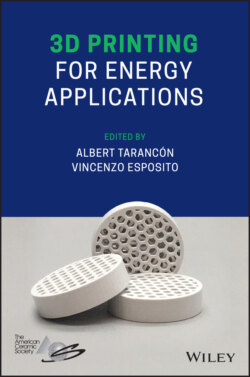Читать книгу 3D Printing for Energy Applications - Группа авторов - Страница 25
1.2.2 Material Gradients in PBF
ОглавлениеThe application of multi‐materials in a component expands the already large design space provided by additive manufacturing processes. Directed energy deposition processes (DED) are typically associated with multi‐material additive manufacturing in metals due to their intrinsic system‐related flexibility of changing to different feedstocks during operation, as further discussed in Section 1.3. However, PBF‐based additive manufacturing processes exhibit specific advantages over DED. A prominent example is the possibility to generate more intricate geometries and achieve smaller feature sizes. At the same time, most commercially available PBF systems are limited to a single powder feedstock restricting the deployment of different materials during the build process. This section deals with Type‐II, III material gradients in PBF [36].
The most common kind of multi‐material PBF components are Type‐II involving the use of an existing prefabricated structure of material A and adding a second material B. While the process itself doesn't change, the multi‐material components often reduce the manufacturing time thus combining the best of conventional and additive manufacturing. Another Type‐II multi‐material methodology involves premixed powder compositions that offer significant improvements in desired properties. The review paper by Bandyopadhyay and Heer [20] showcases several examples of Type‐II PBF multi‐material. More recently, Chen et al. [37] investigated L‐PBF of steel–bronze multi‐material components and found brittle cracks at the interface. Hinojos et al. [38] used EB‐PBF to make IN718/SS316 and SS316/IN718 components and found that the high temperatures in EB‐PBF make it less susceptible to solidification cracking. AlMangour, Grzesiak, and Yang [39], Han et al. ([40]), Kun, Beibei, Wenheng, and Cailin ([41]), and Xia et al. [42] worked with premixed titanium composite powders to improve the wear resistance and hardness of L‐PBF Ti parts. Recent works successfully demonstrated microstructural control during PBF to make Type‐III components. Niendorf et al. [43] used process control to modify the microstructure of SS316 in L‐PBF and Koptyug et al. [44] used a similar mechanism in EB‐PBF of SS316. Biondani, Bissacco, Mohanty, Tang, and Hansen [45] showcased a hybrid process chain to make Type‐II multi‐material L‐PBF components with a mirror‐like finish for molding applications.
Anstaett, Seidel, and Reinhart [46] from Fraunhofer, IGCV showcased a multi‐material FGAM part of Copper–Chrome–Zirconia and Tool Steel 1.2790. New systems were used for handling the selective layout of powder within the individual recoated layer for powder‐bed systems [47]. Demir and Previtali [48] introduced a prototype L‐PBF system with two powder feeders in combination with piezoelectric transducers for in‐situ gradual mixing of Fe and Al‐12Si powder. Wei, Li, Zhang, and Chueh [49] demonstrated, for the first time, full spatial control in all directions in L‐PBF using a custom‐made system with multiple powder feeders and a point‐by‐point micro‐vacuum selective material‐removing system. Figure 1.3 shows the schematic of an Aurora Labs system with custom‐built software for multi‐material processing at DTU [36]. The powder feeder systems are accurate within a 1% error by weight of powder dispensed per layer. This allows precise control of the mixing percentage within each layer. An example is presented with a graded Type‐III steel sample with a hard phase (SS440C) and a soft phase (SS316L) alternating sinusoidally. Preliminary microstructure and microhardness tests reveal that the component is functionally graded as designed. One of the primary concerns of multi‐material PBF is the issue of material waste, due to difficulties in recycling the powder. Aerosint solves this issue through selective powder deposition. At DTU, the issue is addressed by means of tracking software, which automatically adjusts the ratio of the powder materials based on the history of the mixed powder and desired final composition per layer. Bodner et al. [50] used a unique PBF system with integrated liquid dispersed metal powder dispensation. The setup was used to additively manufacture a multilayered structure based on alternating Inconel 625 alloy (IN625) and 316L stainless steel (316L) layers on a 316L base plate. New methodologies for applying multi‐material powder in PBF are necessary for the wider adoption of FGAM components for critical functional applications.
Figure 1.3 Working schematic of the L‐PBF equipment, and functionally graded steel composite components built at The Technical University of Denmark (DTU).
